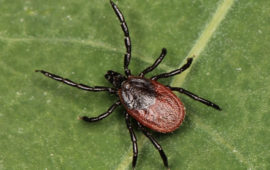This email is an annual email to bring to clients’ attention a likely increase in the prevalence of ticks during the coming season. In my experience, ticks tend to be very active just after the rains, and at their peak from the first rains through early Spring. All things considered, it seems the ticks in our geographic location can be a nuisance, but likely don’t pose serious health risks. Below I address what you can do when you find a tick, some preventative sprays and medication options, and possible health risks.
What to do when you find a tick:
When you find a tick, it’s OK to remove it yourself. For newly-attached/smaller ticks, I recommend using tweezers, and grabbing very close to the head before pulling out. The closer you can get to the head, the less likely it will remain embedded in the skin. Ticks that have only been attached for a short period of time, and not yet fattened up, are actually harder to remove than ticks that have been attached for a while. For fatter ticks, that may have not been discovered early on, I have found that rolling them in circles until they become tired and let go is a very effective/clean way of removing them.
Article on how to remove a tick:
Medications and Preventative Sprays
K9 Advantix ll and Nexgard have both been highly recommended by veterinarians, though Nexgard, along with other pills like Bravecto and Simparica, have recently been linked with potentially causing neurological problems. (Link below) https://www.fda.gov/animal-veterinary/animal-health-literacy/fact-sheet-pet-owners-and-veterinarians-about-potential-adverse-events-associated-isoxazoline-flea
K9 Adnvantix II is a topical medication, usually applied between the shoulder blades of the dog, and is often effective for at least one month after a given dose. Please of course speak with your veterinarian, or do your own research, to find other great tick medication options. I’ve also seen that a natural spray called Wondercide seems to effectively reduce the prevalence of ticks that will climb onto a dog in the first place. It has several active ingredients, including cedarwood oil, that act as repellants to ticks and fleas. (Link below)
Health Risks:
Lyme Disease:
Based on speaking with local veterinarians, and whatI’ve read, the most likely disease that would be transmitted to a dog from a tick in our geographic location is Lyme disease. With that said, I’ve never had in the pack, or heard of, a case of Lyme disease in our area that a dog contracted while staying local. The webpages below I think are useful to get a better idea of Lyme Disease’s prevalence in Los Angeles County. Please of course speak with your veterinarian, as they may have better and more up-to-date information.
In conclusion to health risks, it seems that the likelihood of your dog being infected with a tick-borne disease is low, though not zero, and using a medication to kill any attached or unattached ticks might help err on the side of caution. With this all said, I will be keeping an eye out, and will plan to pick off any ticks I see. Please also feel free to update me with any new information or articles you think could benefit me, or be useful to other clients.
Thank you so much for being part of the pack, and I hope to have another amazing and safe year with the dogs!
Sincerely,
Colin
Some additional articles about tick related health risks below:

